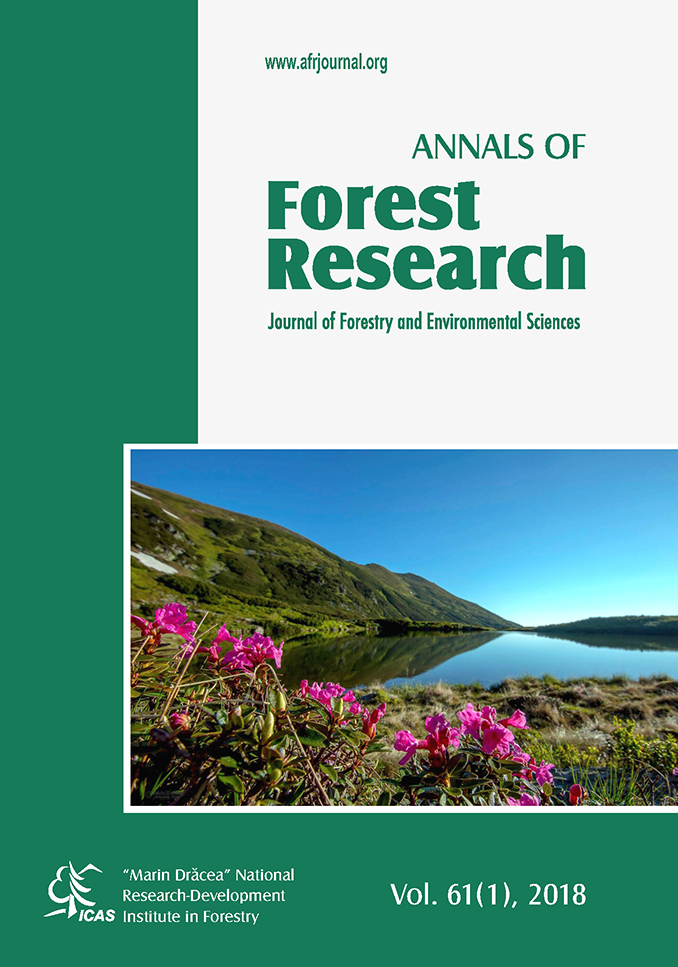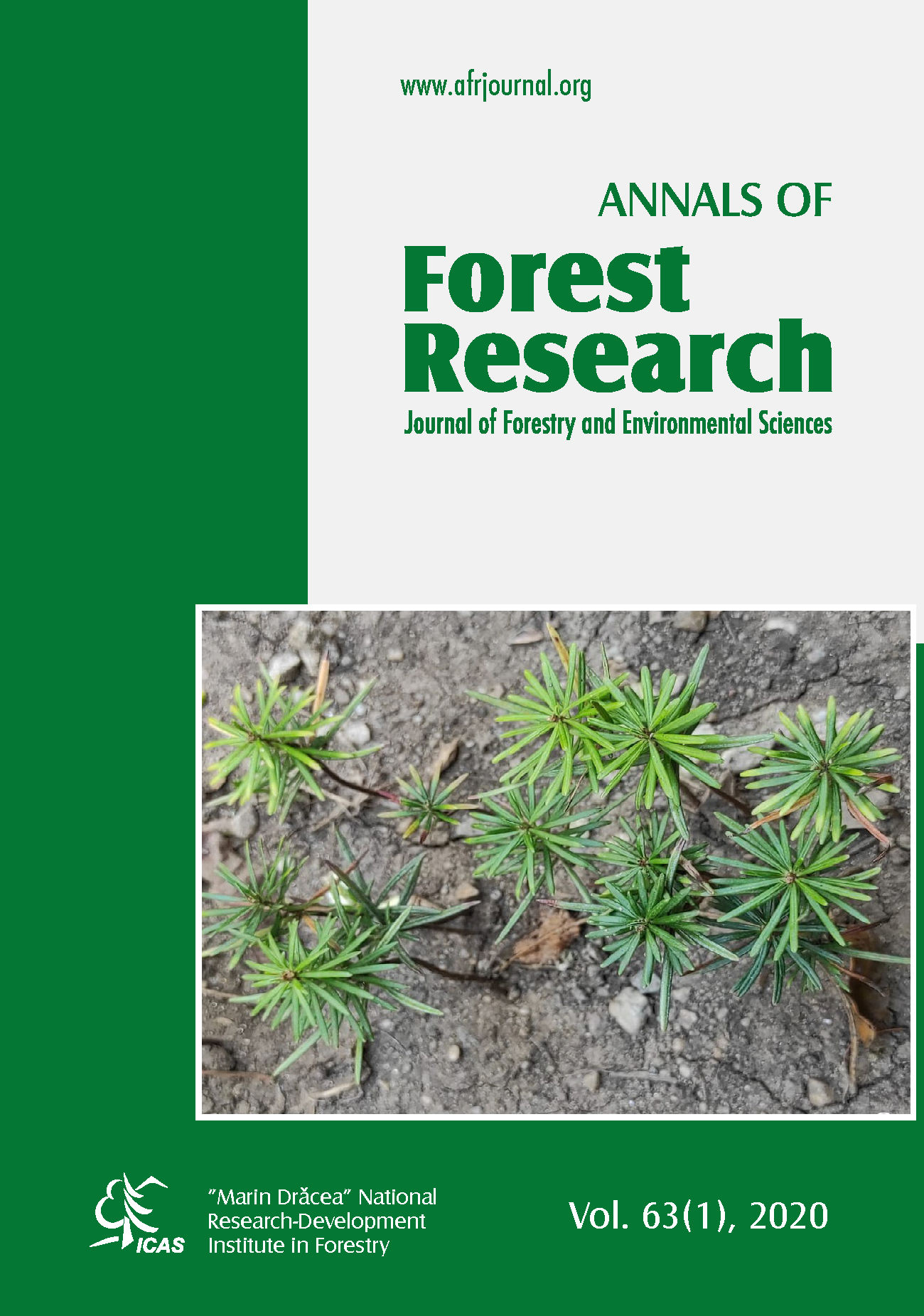A comparison of two methods of data collection for modelling productivity of harvesters: manual time study and follow-up study using on-board-computer stem records
DOI:
https://doi.org/10.15287/afr.2018.962Keywords:
P. patula, cut-to-length harvesting, CTL harvesting, DBH comparison, stem files, productivityAbstract
Productivity of a mechanized P. patula cut-to-length harvesting operation was estimated and modelled using two methods of data collection: manual time study and follow-up study using StanForD stem files. The objective of the study was to compare the productivity models derived using these two methods to test for equivalence. Manual time studies were completed on four different machines and their operators. Two Ponsse Bear harvesters fitted with H8 heads, and two Ponsse Beaver harvesters, fitted with H6 heads, were included. All machines were equipped with Ponsse Opti2 information system. All four operators had approximately 1 year of experience working with their respective machines. The four machines worked in separate four-tree-wide harvesting corridors, and they each harvested 200 trees. Individual tree diameter at breast height (DBH), and height measurements were made manually. Subsequently, data on the trees in each study were extracted from the StanForD stem reports from each of the harvesters. Cycle times in the stem reports were determined based on the difference between consecutive harvest timestamps. The two methods were compared in terms of their abilities to estimate equivalent measures for tree DBH, volume, and productivity. In all four cases, significant differences were found between the DBH and volume measures derived using the two methods. Subsequently, the volume measures from the manual methods were used as the basis for productivity calculations. Results of the productivity comparisons found no significant differences between the models developed from the two methods. These results suggest that equivalent productivity models can be developed in terms of time using either method, however volume discrepancies indicate a need to reconcile bark and volume functions with the high variability experienced in the country.
References
Ackerman P., Gleasure E., Ackerman S., Shuttleworth B., 2014. Standards for Time Studies for the South African Forest Industry. Web: http://www.forestproductivity.co.za/?page_id=678. Accessed August 2, 2017.
Ackerman P., Pulkki R., 2012. Fibre losses of eight softwood clearfell harvesting systems in South Africa. Southern Forests 74(2): 133–149. DOI: 10.2989/20702620.2012.701412
Ackerman P., Williams C., Ackerman S., Nati C., 2017. Diesel consumption and carbon balance in south african pine clear-felling ctl operations: a preliminary case study. Croatian Journal of Forest Engineering 38(1): 65-72.
Ackerman S.A., Seifert, S., Ackerman, P.A., Seifert, T. 2016. Mechanised pine thinning harvesting simulation: productivity and cost improvements as a result of changes in planting geometry. Croatian Journal of Forest Engineering 37(1): 1–15.
Ackerman S.A., Ackerman P.A, Seifert T., 2013. Effects of irregular stand structure on tree growth, crown extension and branchiness of plantation-grown Pinus patula. Southern Forests. 75(4): 247–256. DOI: 10.2989/20702620.2013.846722
Alam M., Brown M., Strandgard M., Fox, J., 2012. Improving the productivity of mechanised harvesting systems using remote sensing. Australian Forestry 75: 238–245. DOI: 10.1080/00049158.2012.10676408
Arlinger J., Moller J., 2007. Information exchange with CTL machines, recent development of StanForD - a communication standard. 3rd Forest Engineering Conference. Skogforsk, The Forestry Research Institute of Sweden. Mont-Tremblant, Quebec, Canada.
Björheden R., Thompson MA., 1995. An International Nomenclature for Forest Work Study. In DB Field (Ed.), Proceedings of IUFRO 1995 S3:04 subject area: 20th World Congress. IUFRO, Tampere, Finland, pp. 190-215.
Bredenkamp V., Upfold S., 2012. South African Forestry Handbook: 5th Edition. Melno Park, Pretoria: South African Institute for Forestry (SAIF).
Brink MP., Malan FS., Kassier HW., 2000. Forest Engineering in Timber plantations: Log definitions and specifications. In Owen D.L. (ed.), South African Forestry Handbook 1: 301-340.
Contreras M., Freitas R., Ribeiro L., Stringer J., Clark C., 2017. Multi-camera surveillance systems for time and motion studies of timber harvesting equipment. Elsevier 135: 208-215.
Cosola G., Grigolato S., Ackerman P., Monterotti S., Cavalli R., 2016. Carbon footprint of forest operations under different management regimes. Croatain Journal of Forest Engineering 37(1): 201-217.
Eliasson L., Bengtsson J., Cedergren J., Lageson H., 1999. Comparison of single-grip harvester productivity in clear and shelterwood cutting. Journal of Forest Engineering 10: 43–48.
Erasmus D., 1994. National Terrain Classification System for Forestry: Version 1.0. Institute for Commercial Forestry Research. ICFR, Pietermaritzburg, South Africa.
Eriksson M., Lindroos O., 2014. Productivity of harvesters and forwarders in CTL operations in northern Sweden based on large follow-up datasets. International Journal of Forest Engineering 25: 179-200. DOI: 10.1080/14942119.2014.974309
Heinemann H., 2001. Productivity of a cut-to-length harvester family - an analysis based on operation data. Proceedings from the 2001 Council on Forest Engineering (COFE): "Appalachian Hardwoods: Managing Change"; July 15-18; Snowshoe, West Virginia.
Holopainen M., Vastaranta M., Rasinmaki J., Kalliovirta J., Makinen A., Haapanen R., Hyyppa J., 2010. Uncertainty in timber assortment estimates predicted from forest inventory. European Journal of Forest Resources 129: 1131-1142. DOI: 10.1007/s10342-010-0401-4
Jirousek R., Klvak R., Skoupy A., 2007. Productivity and costs of the mechanised cut-to-length wood harvesting system in clear-felling operations. Journal of Forest Science 53: 476-482. DOI: 10.17221/2088-JFS
Kanawaty G (Ed.)., 1992. Introduction to Work Study (4th Edn.). Geneva: International Labour Organisation.
Kärhä K., Rönkkö E., Gumse S., 2004. Productivity and cutting costs of thinning harvesters. International Journal of Forest Engineering 15: 43-56
Koskela L., Nummi T., Wenzel S., Kivinen V., 2011. On the analysis of cubic smoothing spline-based stem curve prediction for forest harvesters. Canadian Journal of Forest Research 36: 2909-2920. DOI: 10.1139/x06-165
Kulak D., Stanczykiewicz A., Szewczyk G., 2017. Productivity and time consumption of timber extraction with a grapple sikidder in selected pine stands. Croatian Journal of Forest Engineering 38: 55-63.
Labelle E., Soucy M., Cry A., Pelletier G., 2016. Effect of tree form on the productivity of a cut-to-length harvester in a hardwood dominated stand. Croatian Journal of Forest Engineering 37: 175-183.
Louw J., Scholes M., 2002. The influence of site factors on nitrogen mineralization in forest soils of the Mpumalanga escarpment area: South Africa. South African Forestry Journal 193: 47-63. DOI: 10.1080/20702620.2002.10433518
Magagnotti N., Kanzian C., Schulmeyer F., Spinelli R., 2011. A new guide for work studies in forestry. International Journal of Forest Engineering 24: 249-253. DOI: 10.1080/14942119.2013.856613
Magagnotti N., Pari L., Spinelli R., 2017. Use, utilization, productivity and fuel consumption of purpose-built and excavator-base harvesters and processors in Italy. Forests 8: 485. DOI: 10.3390/f8120485
Magagnotti N., Spinelli R. (eds.)., 2012. Good practice guidelines for biomass production studies. COST Action FP-0902 and CNR IVALSA, Sesto Fiorentino, Italy. Web: http://www.forestenergy.org/pages/cost-action-fp0902/good-practice-guidelines/.
Nurminen T., Korpunen H., Uusitalo J., 2006. Time Consumption Analysis of the Mechanised Cut-to-length Harvesting System. Silva Fennica 40: 335-363. DOI: 10.14214/sf.346
Nuutinen Y., Vaatainen K., Heinonen J., Roser D., Asikainen J., 2008. The Accuracy of Manually Recorded time Study Data for Harvester Operation Shown via Simulator Screen. Silva Fennica 42: 63-72. DOI: 10.14214/sf.264
Nuutinen Y., 2013. Possibilities to use automatic and manual timing in time studies on harvester operations. Thesis dissertation, University of Eastern Finland.
Odhiambo B., 2010. The use of time study, method study and GPS tracking in improving operational harvest planning in terms of system productivity and costs. MSc Thesis, Department of Forestry and Wood Science, Stellenbosch University, Stellenbosch.
Olivera A., Visser R., Acuna M., Morgenroth J., 2016. Automatic GNSS-enabled harvester data collection as a tool to evaluate factors affecting harvester productivity in a Eucalyptus spp. harvesting operation in Uruguay. International Journal of Forest Engineering 27: 15-28.
DOI: 10.1080/14942119.2015.1099775
Palander T., Nuutinen Y., Kariniemi A., Väätäinen K., 2013. Automatic Time Study Method for Recording Work Phase Times of Timber Harvesting. Forest Science. 59: 472-483. DOI: 10.5849/forsci.12-009
Ponsse Oyj, 2017. Ponsse Opti information systems – wood procurement system [online]. Ponsse Oyj, Vierema, Finland. Web: http://www.ponsse.com/products/information-systems/wood-procurement. Accessed: November 13, 2017.
Purfürst FT., 2010. Learning curves of harvester operators. Croatian Journal of Forest Engineering 31: 89-97.
Purfürst FT., Lindroos O., 2011. The correlation between long-term productivity and short-term performance ratings of harvester operators. Croatian Journal of Forest Engineering 32: 509.
R Core Team, 2013. R: A language and environment for statistical computing. Vienna, Austria, R Foundation for Statistical Computing.
Ramantswana M., McEwan A., Pauw J., 2012. Determining the effect of tree size, bark-wood bond strength and tree form on the productivity of an excavator-based harvester in Acacia mearnsii in the KwaZulu-Natal forestry region of South Africa. Southern Forests: a Journal of Forest Science 74: 151–157. DOI: 10.2989/20702620.2012.722823
Ross T., du Toit B., Dovey S., 2005. Nutrient pools in slash loads in Pinus patula sawtimber and pulpwood stands in South Africa. Institute for Commercial Forestry Research, Pietermaritzburg, South Africa.
Sängstuvall L., 2010. Estimates of the productivity of logging operations with a focus on forest fuel extraction. Arbetsrapport 297, Skoglig resurshushållning, Sveriges lantbruks universitet, Institutionen for skoglig resurshusha ̊llning.
Spinelli R., Laina-Relano R., Magagnotti N., Tolosana E., 2013. Determining observer and method effects on the accuracy of elemental time studies in forest operations. Baltic Forestry 19 (2): 301-306.
Spinelli, R., Lombardini, C., Magagnotti, N., 2014. The effect of mechanization level and harvesting system on the thinning cost of Mediterranean softwood plantations. Silva Fennica 48(1): 1-15. DOI: 10.14214/sf.1003
StanForD team, 2007. Standard for Forest Data and communications - main document. Web: https://www.skogforsk.se/english/projects/stanford/stanford-classic-documents/. Accessed: November 13, 2017.
StanForD team, 2012. StanForD listing of variables by category. Version 2012-04-18. Web: https://www.skogforsk.se/english/projects/stanford/stanford-classic-documents/. Accessed: November 13, 2017.
Strandgard M., Walsh D., Acuna M., 2013. Estimating harvester productivity in Pinus radiata plantations using StanForD stem files. Scandinavian Journal of Forest Research 28: 73-80. DOI: 10.1080/02827581.2012.706633
Visser R., Spinelli R., 2012. Determining the shape of the productivity function for mechanized felling and felling-processing. Journal of Forest Research 17: 397–402.
DOI: 10.1007/s10310-011-0313-2
Williams C., Ackerman P., 2016. Cost-productivity analysis of South African pine sawtimber mechanised cut-to-length harvesting, Southern Forests: a Journal of Forest Science 78: 267-274. DOI: 10.2989/20702620.2016.1183096
Published
Issue
Section
License
All the papers published in Annals of Forest Research are available under an open access policy (Gratis Gold Open Access Licence), which guaranty the free (of taxes) and unlimited access, for anyone, to entire content of the all published articles. The users are free to "read, copy, distribute, print, search or refers to the full text of these articles", as long they mention the source.
The other materials (texts, images, graphical elements presented on the Website) are protected by copyright.
The journal exerts a permanent quality check, based on an established protocol for publishing the manuscripts. The potential article to be published are evaluated (peer-review) by members of the Editorial Board or other collaborators with competences on the paper topics. The publishing of manuscript is free of charge, all the costs being supported by Forest Research and Management Institute.
More details about Open Access:
Wikipedia: http://en.wikipedia.org/wiki/Open_access






